Zhongke Risk Control: Development and Market Analysis of the Toy Industry
First, the concept of toys and their characteristics
1, the concept of toys
According to GB6675-2003 "National Toy Safety Technical Specifications", toys refer to all products and materials for children under 14 years of age. The National Toy Safety Technical Specification (GB6675-2014) revised in 2014 stipulates that toys are "design" Toys intended for use by children under the age of 14 are also applicable to products intended for children under the age of 14 who are not specifically designed for play but have a play function. According to the provisions of GB/T4574-2011 "National Economic Industry Classification", "Toy Manufacturing (code C2450)" is subordinate to "Manufacturing (Code C)" under the "Cultural Education, Industry, Sports and Entertainment Products Manufacturing ( The code is C24)". Toy manufacturing refers to the use of children as the main user for the production of entertainment equipment such as play and intellectual development. According to the National Bureau of Statistics' "Cultural and Related Industries Classification (2012)", "Toy Manufacturing" is a member of "Cultural Supplies". Production."
There are many types of toys. According to the main materials, toys can be divided into plastic toys, plush toys, cloth toys, wooden toys, metal toys, paper toys, etc. According to the main functions, toys can be divided into educational toys and mobile toys. , electric toys, electronic toys, smart toys, etc.; according to the age of users, toys can be divided into baby toys, baby toys, children's toys, children's toys and adult toys; according to the relationship with animation, toys can be divided into anime toys and non- Anime toys.
2, the characteristics of the toy
â‘ entertainment: toys can give the user plenty of freedom of operation, a variety of toys to meet the preferences of different users and in compliance with the level of ability. Through toys, users enjoy the fun of play, watching, puzzle and even exercise. Toys bring many aspects of happiness and meet different levels of psychological needs;
2 Cultural education: Infancy, the color of the toy is bright, the shape is beautiful, the sound is pleasant and the operation is simple. It becomes the best carrier for children in infants and young children to know the world and explore the world. In early childhood, toys can not only cultivate children's good character, It is also an effective means of ideological and moral education; in the adolescence period, combining toys and multimedia elements can stimulate children's curiosity to explore unknown things, understand the world's customs, broaden their horizons, exercise their thinking ability and hands-on ability;
3 Diversity: There is a difference in the audiences facing each type of toy, and the demand in the toy market is changeable. In addition, there are also differences in different regional cultures, consumption habits, cultural practices, etc., which make the toy products diverse;
4 Trends: Throughout the history of toy development, each toy has the characteristics of its historical trend, regardless of its style, materials and image. Toy manufacturers will choose the products that most cater to the market trend according to different market trends.
Second, the toy industry related policy trends
1. Fertility policy
The number of children directly determines the basic scale of the toy market, especially for children aged 0-12, who have always been the main force in toy consumption. The famous baby boom in American history began in 1945 when the World War II soldiers returned to China. In the 1960s and 1970s, the American toy industry experienced a wave of growth, and at the end of the 20th century, the first wave of baby boomers were adults. Born to have their own children, formed a "returning tide", further promoting the development of the toy industry. The official implementation of the second-child policy on January 1, 2016 in China means that China is likely to usher in a new baby boom, and newborn babies will directly drive the sale of infant toys.
2. Safety Guidelines Policy
Since the main consumer of the toy industry is children, the safety standards for the toy industry have been constantly improving. Countries are increasingly demanding and improving the quality, environmental protection and safety of the toy industry. This trend will continue and become stricter with the improvement of people's living standards and quality. In the case of the European Union, its safety standards have been continuously upgraded since 2003. In 2011, the EU issued the industry's “most stringent safety regulationsâ€. According to statistics, the number of Chinese toy manufacturing companies decreased by 678.
3. Cultural industry policy
The cultural industry is like the spiritual food of a country. All countries in the world attach great importance to this, especially the introduction of relevant content abroad is quite strict. In terms of industrial policies, China's support for domestic animation, online games and other industries has been continuously enhanced, and different restrictions have been imposed on foreign related industries, such as restricting the broadcasting of foreign cartoons during the prime time of TV stations to promote the development of domestic related industries. This trend will continue in the light of our social form and national institutional system.
Third, the toy industry business model
There are three main business models in the toy industry: OEM mode, ODM mode and OBM mode. Among them, OEM mode and ODM mode are the most common business models of domestic toy companies.
1, OEM mode
OEM, the abbreviation of Original Equipment Manufacturer in English, that is, OEM production, brand producers do not directly produce products, but use their key core technologies to design and develop new products, control sales channels, and specific processing tasks are ordered through contracts. The way to commission other manufacturers of similar products, and then buy the low-priced products, and directly paste their own brand trademarks. The manufacturer that undertakes the processing task is called an OEM.
2, ODM mode
ODM, the abbreviation of English Original Design Manufacturer, refers to the manufacturer to develop and design products according to the needs of the market and the requirements of the purchaser. The manufacturer has certain design capabilities and technical level, produces products based on authorized contracts, and affixes the customer's brand.
3, OBM mode
OBM, the abbreviation of English Own Brand Manufacture, that is, the self-owned brand business model, refers to the independent development of the brand and the intellectual property rights of its own brand. The company independently carries out design, research and development, procurement, production, and market development and sales with its own brand. At present, a few dominant toy companies in China adopt this business model. This model independently develops new products according to market demand, sells them under independent brands, and can independently control and make decisions on the economic benefits generated by the brands, and obtain high added value brought by the brands. Can get higher than the market profit margin. In addition, the construction of independent brands can cultivate customers' loyalty to brands and enterprises, and indirectly create value for enterprises.
The comparison of various business models is shown in the following figure:

Fourth, the current situation of the toy industry analysis
1. Status of the global toy industry
The global toy industry showed a moderate development in 2002-2016. From 2002 to 2013, the growth of the toy market in Western Europe and North America was weak. The growth of the global toy market was mainly supported by the Asia-Pacific region with a large number of children and sustained economic development. In 2014-2016, benefiting from the recovery of the toy market in North America and Western Europe and the continued development of the toy market in the Asia Pacific region, global toy sales have grown for three consecutive years, with cumulative toy sales of US$7.327 billion. The global toy industry sales statistics for 2002-2016 are as follows:

In recent years, toy consumption has gradually extended from mature European and American regions to emerging markets, and toy consumption in Asia, South America and Australia has grown rapidly. The toy industry in developed countries such as Europe, the United States, and Japan is mature. Toy companies rely on the mature business model of “brand + channel†to occupy the high value-added links of the toy industry chain. The concentration of industries is high, and large brand toy companies occupy a large market. Share. The world's top five toy brands are from developed countries, namely the United States' Mattel and Hasbro, Japan's Dome and Bandai and Denmark's Lego. These toy giants are at the forefront of the global toy market with their large scale, well-known brands, strong R&D capabilities, novel ideas, infiltration methods at home and abroad, and stable sales channels. The market concentration of the world's top five toy companies is 30.8%, and in 2009-2016 it is basically floating around 30%. The top five toy companies have the market share of toys as shown below:
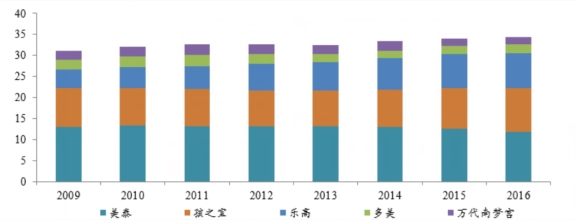
2. Current status of China's toy industry
China is the world's largest toy manufacturing and exporting country. In the early days, the toy industry achieved rapid development with low labor costs and large-scale processing capabilities. Although the labor cost is rising, the toy manufacturing base has a tendency to shift to Vietnam, Poland and other places. However, in the short term, China's basic advantages will not change, and China's toy manufacturing industry still maintains a good momentum of development. According to Euromonitor's forecast of China's toy sales growth rate, China's toy sales will increase by about 5% to 6% in the next five years. It is estimated that toy sales will reach about 14 billion US dollars in 2021. The sales of toys and sales growth in China in the next five years are as follows:

Although the total consumption of China's toy market has shown a growth trend over the years, there is still a big gap between the average household toy consumption and the mature world market of toys and even some emerging market countries. The average toy consumption of the top three toys in the United States, China, and Japan was 391.9 US dollars, 43.3 US dollars, and 326.3 US dollars respectively. The average toy consumption of children in the United States and Japan was more than 7 times that of China, mainly because of the US and Japan. Per capita GDP is much higher than China. With the increase in per capita income, the average toy consumption of children has increased, and there is still much room for growth in the Chinese toy market.
V. Current opportunities for the development of China's toy industry
1. The per capita disposable income of urban and rural residents in China shows an increasing trend
From 2007 to 2016, the disposable income of urban residents in China increased from 13,786.00 yuan to 33,616.00 yuan, an increase of 1.44 times, and the compound annual growth rate reached 10.41%. In the same period, the per capita disposable income of rural residents increased from 4,140.00 yuan to 12,363.00 yuan, an increase of 1.99 times. The compound annual growth rate is 12.93%. The income level of urban and rural residents has increased, and the purchasing power of household toys has increased. This trend will continue to release consumption potential as China's economic development and income distribution system improve. The disposable income of urban and rural residents in China is as follows:
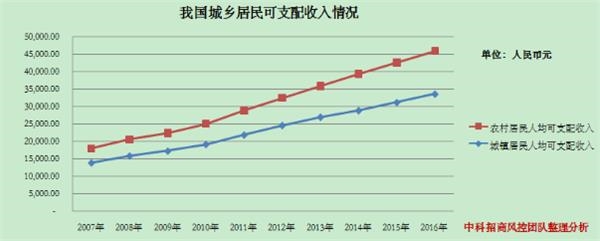
2, the implementation of the second child policy, the number of newborn babies will increase in the future
The number of children is very important to the toy industry, which directly determines the basis size of the toy market. In December 2013, China began to gradually open a separate second-child policy. By January 1, 2016, the second-child policy will be officially implemented, which will lead to another wave of baby boomers in China. The new generation of services is mostly after 80 and 90, and the consumption concept and Consumption habits are more modern, focusing on children's educational and entertainment needs, and toy consumption will gain more space. According to Euromonitor's forecast, the number of children aged 0-14 in China will reach 260 million in 2030, compared with 20 million children in 2016. According to the average children's consumption of 43.4 US dollars in 2016, the sales of toys brought by the number of newly added children is about 869 million US dollars. The changes in the habitat of children aged 0-14 in China predicted by Euromonitor are shown in the following figure:

3. Science and technology innovation promotes the upgrading of product structure in the toy industry
New technologies such as information technology, intelligent technology, microelectronics technology, and sensor technology are continuously applied to the toy field, which makes toys have better effects in terms of intelligence, interaction, and intelligibility. The high-level consumption structure is widened. The market space of science and technology toys has greatly enhanced the technical level of the entire industry, providing an opportunity for the toy industry to get rid of low-level cost competition. With the advent of the intelligent era, more and more toys have electronic functions, and the structure of toy products is gradually becoming electronic. The growth rate of most toy products is higher than that of non-electronic versions, contributing to toy sales. more and more. The composite growth rate of electronic toy sales in various regions in 2005-2016 is compared with the overall compound annual growth rate as shown in the following figure:
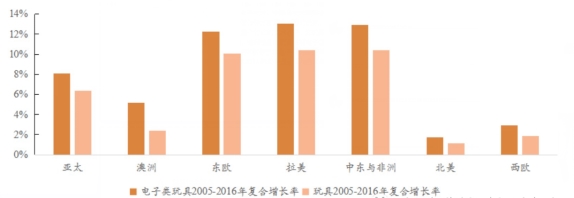
Sixth, the toy industry barriers
1. R&D design barriers
With the upgrading of people's consumption concept, people pay more and more attention to the role of toys in the growth of children. The higher the individualized demand for toys, such as intelligence, interactivity and education, requires toy companies to have high R&D strength and develop A collection of products that meet the needs of consumers. On the other hand, the consumer market is changing rapidly, the popularity cycle of toy products is short, and the popularity of popular elements is fast. It requires toy companies to have strong product innovation awareness and innovation ability, design products that meet the mainstream market demand, and lead the toy fashion trend. Therefore, for new companies entering the industry, there are major barriers in terms of new product development, design capabilities, and market trends.
2. Product sales channel barriers
A sound sales network and a stable quality customer base are important competitive factors for toy companies. Enterprises not only need to invest a lot of manpower, financial resources, and material resources in the early stage, but also need to improve after a long period of time to form a sales network with strong sales capabilities. The stability of high-quality customers requires long-term investment and time precipitation. Only by establishing long-term cooperative relationships with upstream and downstream terminal customers and distributors can the company's product value, price, delivery time, post-service and billing period Trust in the field and long-term stable cooperative relations, these resources are great obstacles for new entrants.
3. Corporate brand effect barriers
The main consumer groups of toy products are children. Toys not only affect children's growth, but also related to children's safety and health. Therefore, parents are more inclined to choose well-known brands that have gradually formed after being tested by users and market competition, such as Bandai. Hasbro, Mattel, Lego and other international first-class brands, its brand effect has been enduring for a long time, and is deeply recognized by the society. However, the company's shaping and maintaining the brand image requires long-term and continuous investment in product quality, corporate culture, technology research and development, and marketing channels. This is an obstacle that new entrants are difficult to overcome in the short term.
4. Safety and environmental protection standard barriers
In order to protect children's health and safety, countries have strict regulations on the safety and environmental protection of toys and materials. China implements compulsory certification for the quality and safety of toys; internationally, the United States implements a toy product safety certification program, the EU implements the "EU New Toy Safety Directive", and the Indonesian children's toys implement Indonesian national standards. Only after long-term operation and accumulation in the industry can toy companies achieve various certification standards in terms of product quality, etc. New entrants are difficult to meet various standards in a short period of time, and the higher additional costs incurred in meeting the standards will also greatly reduce their Product competitive advantage.
Seven, the toy industry competition pattern
1. International first-line brand
The global toy industry is highly concentrated. The top five toy companies are the United States' Mattel and Hasbro, Japan's Dome and Bandai, and Denmark's Lego. The five toy giants use IP to drive the entire industry chain and global strategy to secure a 30% share.
Among them, Mattel, Hasbro, Bandai, and Tomi have taken a diversified development path, involving multiple sub-sectors, and occupying leading positions in various sub-sectors, such as Mattel in infant toys, dolls, model cars. It can occupy a leading position in four sub-sectors, such as a toy car. Wanda and Dome are inferior to Mattel and Hasbro, but they also occupy a lot of market share in various segments. Lego is different from most giants. Although LEGO has tried to take a diversified path in history, due to the excessively dispersed industry, its core product, the “Lego Building Modelâ€, lacks innovation, resulting in a decline in operating income. The strategy refocused on the development of building model toys and cut down sectors with less than 13.5% net profit. The market share of the top five toy companies is shown in the following figure:
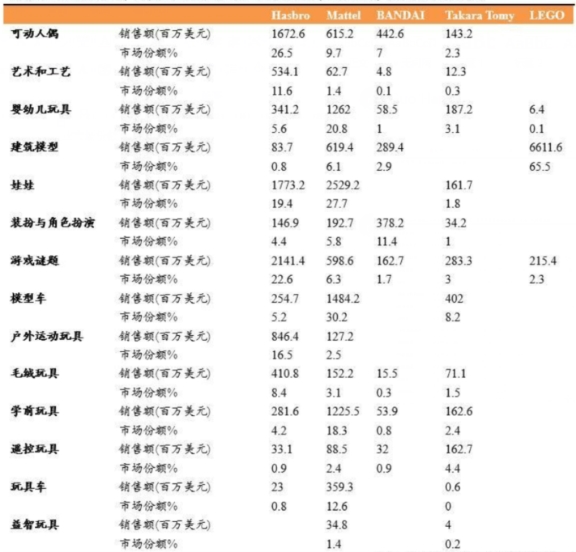
1 Mattel (Mattel USA)
Mattel Toys is one of the world's largest toy manufacturers and the largest toy company in the United States. Its products account for 17% of domestic sales. The company was founded in 1945. In 1959, Mattel launched Barbie dolls and became a hit. It has ushered in a period of rapid growth; the company's products include: Fisher, Barbie, Monster High Doll, Hot Wheels and Matchbox Toys, Cosmic Dominant, American Girl Doll, Board Game, WWE Toys, etc. Founded in 1945, it is a leader in the design, production and sales of children's products.
2 Hasbro (Hasbro USA)
Hasbro is the second largest toy company in the United States, and its products account for 10% of the US toy industry. The company was founded in 1923. The company sold textile trims at the beginning of its establishment and later turned into a stationery company. In 1935, the company relied on Monopoly Monopoly. It has gradually become a world-class toy company with various famous brands such as Transformers, Special Forces and Star Wars. Similar to Mattel, in addition to the traditional toy business, Hasbro is also working with various film and television companies to make the toy business vibrant through its own and authorized image from the film and television. At present, Hasbro has licensed many core brands to film and television companies, such as "Transformers" and "Magic The Gathering". In addition to authorized production, Hasbro has set up its own studio, which mainly produces TV programs for its popular toy brands, as well as creative content from third parties.
3 thousand generations (Ban Dai Japan)
Bandai is the largest toy company in Japan. The company was founded in 1955. It mainly involves entertainment, internet, animation products and its surroundings. It produces a large number of sci-fi and animation models, and the variety is the world's number one. At present, the company's toy products mainly include Warrior Gundam series, dinosaur team series, steel warrior series, Altman, Dragon Ball, Masked Superman and other anime-derived toys, among which the most famous ones are non-high-end series. Headquartered in Tokyo, Japan, the company has 27 subsidiaries in eight major regions of the world. In addition to toys and children's entertainment, Bandai's global reach includes game software, multimedia, music, feature films, vending machines, game cards, candy and licensed clothing.
4 more beautiful ( T akara T omy Japan)
Tomei (formerly Japan's third largest toy company) and TAKARA (formerly Japan's second largest toy company) officially merged in March 2006, becoming a new force in the world of toys, children's products and entertainment industry, the new company after the merger It is called "Dome Beauty Co., Ltd.", and its combined name in Japan is Takara Tomy. Since 2007, many hairdressing products have sold a lot of fun, entertaining and high-quality products for children of different ages, including not only the beautiful self-owned brands, but also other brand-licensed products. Tomei is the Chinese market officially entered in 2004, and brought its two most powerful brands, Domeca and Pule Road, into China. After more than 7 years of continuous development, the sales of toys including Domeca, Pule Road, Disney, Thomas, Girls' Toys, Baby Toys, etc. have grown significantly. Tomei has become an indispensable part of the Chinese toy market. The leading toy brand.
5 LEGO (LEGO Denmark)
LEGO is the world's largest manufacturer of building block toys and has a strong R&D team. The company was founded in 1932 and its products are designed to allow children to develop intelligence while playing. The company's products are sold to more than 130 countries and regions around the world, including girls series, creative building series, Star Wars series, hero factory series, toy mobilization series and so on. In recent years, Lego has continued to work with well-known brands such as Harry Potter, DC, Marvel, Warner Bros. Pictures. At present, Lego Film has launched a series of animations such as "Biochemical Warrior" series, "Lego Movie", Justice League theme, "Lego Ninja Series Movie". The 2016 data shows that Lego has a 65.51% sales of global architectural model toys with a gross margin of 71.95%.
2. Domestic toy company
Among the domestic toy companies, Aofei Entertainment and Shanghai Yaojiju ranked the first echelon, of which the market share of Aofei Entertainment rose from 3.4% in 2009 to 5.3% in 2016, ranking first in China's largest toy company; Both the Creators and the Bangbao puzzles have made great achievements in their respective toy fields, and their market share has been rising. Shanghai Yaoji relies on domestic chess culture and has become the second largest toy company in China through mergers and acquisitions. The pattern of domestic toy companies is shown in the following figure:

The sales of the first echelon's Aofei and Yaoji toys grew rapidly. In 2016, the growth rate was 26% and 18% respectively. Aofei Entertainment has multiple toy fields. Shanghai Yaoji focuses on poker brands; the second echelon only Smart Ingenuity is outstanding, with a growth rate of 25% in 2016. Smart Ingenuity focuses on movable dolls and outdoor sports toys; Bangbao Puzzle specializes in building blocks; Qunxing Toys officially stripped the toy business to non-listed companies in December 2016. Before the group toys products are mainly low-end children's toy products and remote control toys; Starlight Entertainment focused on games, toy business only accounted for 20%; Bainshi, Xiaobailong, Tianheng shares, Kaidiwei, Jia in the third echelon New three-board companies such as Qi Technology grew rapidly in 2016. The sales growth rate in 2016 was 49%, 53%, 49%, 76%, and 39%, respectively.
The financial data of domestic listed toy companies and new three board listed toy companies are shown in the following table:
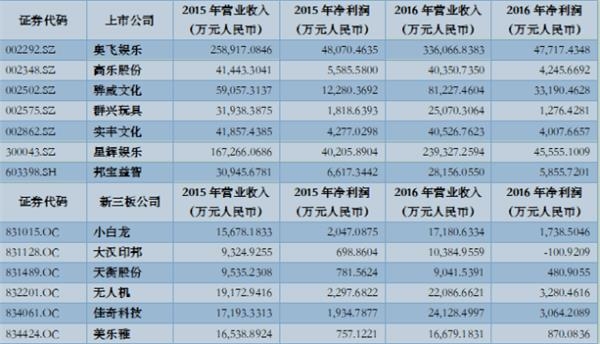
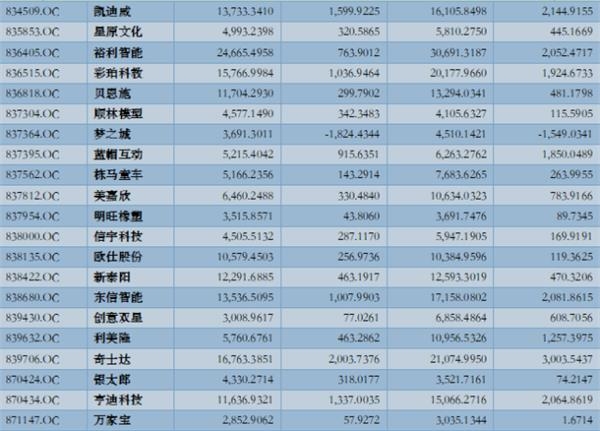
Source: Wind Information
3. Potential new company
Derivatives with IP as the core authorization, especially derivative toys, have broad market prospects. Stronger Internet companies, online game companies, and pure animation companies have increased their "invasion" efforts and become potential new emerging competitors in the industry. In recent years, with the support of the government, a large number of outstanding domestic cartoons have emerged, such as "Pleasant Goat and Big Big Wolf", "Bear Infested", "Pig Pig Man", etc. These image and animation works accelerate the realization of animation derivative toys. For example, in 2016, the size of the animation derivative market was 45 billion yuan, a year-on-year increase of 18.42%. As animation derivatives become the main source of income for the animation industry, the huge space of the derivatives market is opening. As the most profitable part of the animation industry, derivatives are paying more and more attention to the establishment of an IP-based entertainment industry chain. The big companies that once started relying on derivatives have now emphasized the “pan-entertainment ecologyâ€. Alibaba, Baidu, Tencent, Wanda and various well-known film and television companies have begun to lay out the derivatives industry. The scale of the Chinese animation derivatives market is shown below:
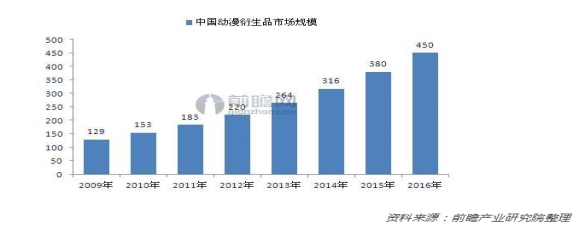
Reference materials:
(1) "China Toy Industry Development Trends"
(2) "Guangxu Hengsheng Toy Industry Series Special Topics"
(3) Network information such as Juchao Information, Wind Information, Foresight Network, and Guangzheng Hang Seng
Kitchen Organization,Pantry Organization,Kitchen Organiser,Drawer Organiser
NINGBO HOZ TRADING CO.,LTD , https://www.hoz-kitchenware.com